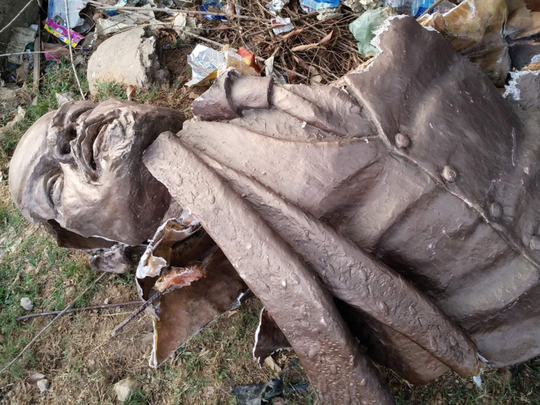
Chennai is the place to be if you have an irresistible urge to topple statues, either because of your political leaning or you can’t stand those things.
The city, earlier called Madras by the Brit rulers, today has statues all over the place and they pop up even at traffic lights, with the person pointing a finger into the distance or looking pensively at people perspiring furiously in the muggy weather.
Many of the statues are of famous movie stars turned politicians and they are mostly gilded, unlike the Gandhi statue on the Marina Beach Road, which is jet-black granite. The sculptor has frozen the Father of the Nation in a loin cloth and walking briskly with the aid of a stick. (Incidentally, Ben Kingsley, who portrayed the national icon in the movie Gandhi, captured his energetic walk perfectly). My wife’s uncle who drove us around Chennai gave us an alternative version of how the sculptor of the equestrian statue of Thomas Munro, Governor of Madras, committed suicide when he was ridiculed because he forgot incorporating the saddle and stirrups.
The statue is also known as the “Stirrupless Majesty” and the sculptor deliberately omitted the saddle and stirrups as Munro liked bareback riding.
Toppling statues became a recent trend after Lenin’s statue in Belonia Town College Square in Tripura state was brought down by the nationalist Bharatiya Janata Party (BJP) workers after the party dethroned the communists in recent elections.
Soon after that, Gandhi’s statue was defaced, the statue of Ambedkar, India’s champion of human and civil rights and leader of the country’s backward classes, was disfigured.
In Tamil Nadu state, the statue of Dravidian icon E.V. Ramasamy (also known as Periyar) was vandalised. Then in Kolkata, in a tit for tat, the statue of BJP founder, Syama Prasad Mookerjee, was blackened with paint.
Luckily, by the time we landed in Chennai, the hullabaloo over statues had ended, or our short trip would have been ruined trying to avoid all those falling statues.
We were in Chennai, trying to figure out where in India to live. One thing in the city’s favour is that you can get lovely eats called “tiffin” such as ‘dosa’, ‘idli’, ‘vada’ and of course, the famous filter coffee.
The other thing in its favour is that Chennai has the world’s longest urban beach (six kilometres) and is wide and sandy.
But on the other hand I wondered how the Brits lived in Chennai with its scorching summers. It did not help to know that Governor Munro had died after contracting cholera.
Feline tales
We got to know a different Chennai from the uncle, who while driving through a street told us a story about a gentleman who lived near Eliot’s Beach and had owned two tigers. “That is why this street is called Tiger Varadhachari Road,” he said.
(I quickly got down and took a picture of the sign and planned to upload it on Instagram, but the story again is not true. Varadhachari was a Carnatic music vocalist and the title Tiger was given to him by the Maharaja of Mysore).
Not to be outdone, my wife and I told him about how tough it is taking an endangered animal for walks so they are taken for a ride instead in luxury cars and the animals have a great time with the sea breeze blowing through their mane.
And we also told him about the time a tiger jumped out of a car and started walking on the busy road and somehow that did not create a panic on the highway.
Mahmood Saberi is a storyteller and blogger based in Bengaluru, India. Twitter: @mahmood_saberi.












